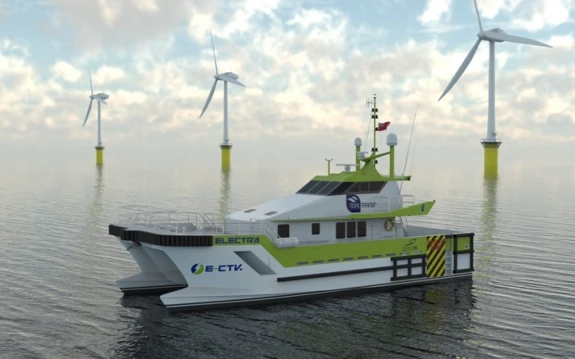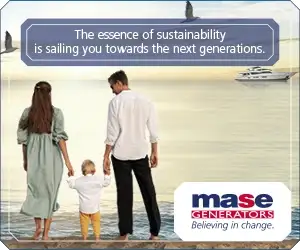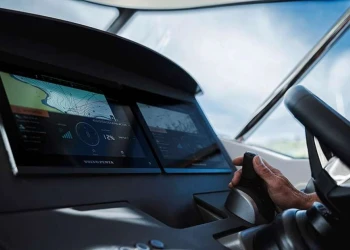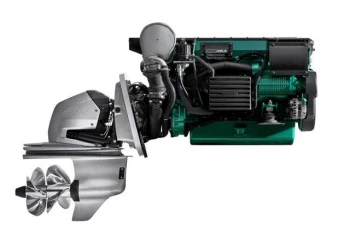
World-first electric CTV to be built in UK with Volvo Penta IPS
World-first electric CTV to be built in UK with Volvo Penta IPS
A Crew Transfer Vessel’s diesel engines will be replaced with a zero-emissions Volvo Penta solution to create the world’s first retrofitted Electric Crew Transfer Vessel (E-CTV). Using an existing vessel delivers better circularity and sustainability and helped make the project one of just 10 leading-edge developments awarded UK government funding as part of an industry-led transition to net-zero.
Volvo Penta will provide the power solution for a ground-breaking vessel for the UK’s offshore industry. The company will supply its advanced Inboard Performance System (IPS) for the world’s first retrofitted, electric crew transfer vessel (E-CTV). For the project, Volvo Penta will supply a fully electric propulsion system in an existing vessel, replacing the older combustion engines with a 100% emissions-free solution. It’s the latest marine project to harness Volvo Penta IPS as part of a transition to more sustainable boating and comes just weeks after the announcements of similar collaborations with Northern Offshore Services and Sanlorenzo Yachts.
“We are delighted to be involved with such a landmark project, which will feature our first ever Volvo Penta IPS powered 100% by batteries and with no on-board diesel generators. It’s an ultra-efficient set-up that will deliver longer-range and emissions-free transfers. There’s also closer control and maneuverability so journeys are safer, faster and more reliable. We believe this is the future for a number of segments within the marine industry and hope it will inspire further projects,” said Mehmet Belibagli, Sales Manager, Marine Commercial at Volvo Penta UK.
The vessel is being developed for sea transport and crew transit service operator Tidal Transit. Cost of the retrofit is estimated at £8 million (€9.4 million) with £6.3 million (€7.4 million) coming from the Zero Emissions Vessel and Infrastructure (ZEVI) program. The program is part of the UK Government's plan (via its Department of Transport and Innovate UK innovation agency) to develop, deploy and operate clean maritime solutions.
Cleaner and leaner
Retrofitting will be done on Ginny Louise, a 20 m, diesel-powered Mercurio vessel. The old propulsion system will be replaced with a Quad Installation of Volvo Penta IPS 30 paired with fully electric motors and over 2 MW of on-board battery capacity. The completed vessel will be re-named e-Ginny and as well as being emissions-free will also benefit from a host of additional benefits that IPS delivers. This includes seamless movement and control, courtesy of the forward-facing, individually-steerable drives with twin counter-rotating propellers. It’s a unique design that not only delivers better maneuverability but also a smoother ride.
For the captain and vessel operators there will be changes to the helm station with the switch to Volvo Penta IPS. These will include Volvo Penta’s Joystick Control, for fingertip movements, Assisted Docking, for stress-free positioning, and the Glass Cockpit System for a smoother driving experience. It’s part of a helm-to-prop retrofit solution that delivers improved performance and driving experience.
“Our vision is to become world leaders in sustainable power solutions and being selected for this ground-breaking project shows the important steps we are making towards our goal. We believe there are many paths to net-zero, and it’s important we support our customers along whichever route they choose. It’s also important to remember the importance of remanufacturing and circularity in achieving our targets. It’s part of our business where we are putting greater emphasis and projects such as e-Ginny are a great example of how it can be done,” said Jan-Willem Vissers, Director, Marine Commercial at Volvo Penta.
As part of the overall Tidal Transit project, new charging infrastructure will be installed, both through an onshore charging station and an offshore wind turbine-based charger. In combination with the ultra-efficient Volvo Penta IPS platform, this will greatly increase the range of the vessel and the amount of time it can spend at work. Once complete, the E-CTV will support crew transfers at an offshore UK windfarm for a period of three years.
Leo Hambro, Commercial Director at Tidal Transit, said: “The transition to electric crew transfer vessels marks a major step towards achieving a more sustainable and environmentally responsible offshore wind industry. Electrification projects like the e-Ginny retrofit offer great benefits from a national to international scale – alongside a substantial reduction in carbon footprint, the absence of combustion engines also contributes significantly to lowering noise pollution, eliminates the risk of fuel spillages and translates into lower maintenance requirements. With the addition of onshore and offshore charging solutions, these vessels can stay on the water for longer, ultimately reducing operational costs for fleet operators.
We’re thrilled to be working with the team at Volvo Penta for their expertise in electric propulsion systems, and together with our other project partners we’re looking forward to continuing our mission to drive the offshore transport industry into a new zero-carbon era.”





